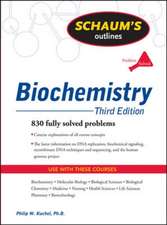In Situ Hybridization Protocols: Methods in Molecular Biology, cartea 326
Editat de Ian A. Darby, Tim D. Hewitsonen Limba Engleză Paperback – 9 dec 2010
| Toate formatele și edițiile | Preț | Express |
|---|---|---|
| Paperback (1) | 634.14 lei 43-57 zile | |
| Humana Press Inc. – 9 dec 2010 | 634.14 lei 43-57 zile | |
| Hardback (1) | 648.89 lei 43-57 zile | |
| Humana Press Inc. – 15 dec 2005 | 648.89 lei 43-57 zile |
Din seria Methods in Molecular Biology
- 9%
 Preț: 791.63 lei
Preț: 791.63 lei - 23%
 Preț: 598.58 lei
Preț: 598.58 lei - 20%
 Preț: 882.98 lei
Preț: 882.98 lei -
 Preț: 252.05 lei
Preț: 252.05 lei - 5%
 Preț: 802.70 lei
Preț: 802.70 lei - 5%
 Preț: 729.61 lei
Preț: 729.61 lei - 5%
 Preț: 731.43 lei
Preț: 731.43 lei - 5%
 Preț: 741.30 lei
Preț: 741.30 lei - 5%
 Preț: 747.16 lei
Preț: 747.16 lei - 15%
 Preț: 663.45 lei
Preț: 663.45 lei - 18%
 Preț: 1025.34 lei
Preț: 1025.34 lei - 5%
 Preț: 734.57 lei
Preț: 734.57 lei - 18%
 Preț: 914.20 lei
Preț: 914.20 lei - 15%
 Preț: 664.61 lei
Preț: 664.61 lei - 15%
 Preț: 654.12 lei
Preț: 654.12 lei - 18%
 Preț: 1414.74 lei
Preț: 1414.74 lei - 5%
 Preț: 742.60 lei
Preț: 742.60 lei - 20%
 Preț: 821.65 lei
Preț: 821.65 lei - 18%
 Preț: 972.30 lei
Preț: 972.30 lei - 15%
 Preț: 660.49 lei
Preț: 660.49 lei - 5%
 Preț: 738.41 lei
Preț: 738.41 lei - 18%
 Preț: 984.92 lei
Preț: 984.92 lei - 5%
 Preț: 733.29 lei
Preț: 733.29 lei -
 Preț: 392.60 lei
Preț: 392.60 lei - 5%
 Preț: 746.26 lei
Preț: 746.26 lei - 18%
 Preț: 962.66 lei
Preț: 962.66 lei - 23%
 Preț: 860.22 lei
Preț: 860.22 lei - 15%
 Preț: 652.64 lei
Preț: 652.64 lei - 5%
 Preț: 1055.50 lei
Preț: 1055.50 lei - 23%
 Preț: 883.87 lei
Preț: 883.87 lei - 19%
 Preț: 491.89 lei
Preț: 491.89 lei - 5%
 Preț: 1038.86 lei
Preț: 1038.86 lei - 5%
 Preț: 524.16 lei
Preț: 524.16 lei - 18%
 Preț: 2122.34 lei
Preț: 2122.34 lei - 5%
 Preț: 1299.23 lei
Preț: 1299.23 lei - 5%
 Preț: 1339.12 lei
Preț: 1339.12 lei - 18%
 Preț: 1390.26 lei
Preț: 1390.26 lei - 18%
 Preț: 1395.63 lei
Preț: 1395.63 lei - 18%
 Preț: 1129.65 lei
Preț: 1129.65 lei - 18%
 Preț: 1408.26 lei
Preț: 1408.26 lei - 18%
 Preț: 1124.92 lei
Preț: 1124.92 lei - 18%
 Preț: 966.27 lei
Preț: 966.27 lei - 5%
 Preț: 1299.99 lei
Preț: 1299.99 lei - 5%
 Preț: 1108.51 lei
Preț: 1108.51 lei - 5%
 Preț: 983.76 lei
Preț: 983.76 lei - 5%
 Preț: 728.16 lei
Preț: 728.16 lei - 18%
 Preț: 1118.62 lei
Preț: 1118.62 lei - 18%
 Preț: 955.25 lei
Preț: 955.25 lei - 5%
 Preț: 1035.62 lei
Preț: 1035.62 lei - 18%
 Preț: 1400.35 lei
Preț: 1400.35 lei
Preț: 634.14 lei
Preț vechi: 746.05 lei
-15% Nou
Puncte Express: 951
Preț estimativ în valută:
121.36€ • 126.23$ • 100.19£
121.36€ • 126.23$ • 100.19£
Carte tipărită la comandă
Livrare economică 14-28 aprilie
Preluare comenzi: 021 569.72.76
Specificații
ISBN-13: 9781617375446
ISBN-10: 1617375446
Pagini: 284
Ilustrații: XII, 270 p. 68 illus., 1 illus. in color.
Dimensiuni: 152 x 229 x 17 mm
Greutate: 0.4 kg
Ediția:Softcover reprint of hardcover 3rd ed. 2006
Editura: Humana Press Inc.
Colecția Humana
Seria Methods in Molecular Biology
Locul publicării:Totowa, NJ, United States
ISBN-10: 1617375446
Pagini: 284
Ilustrații: XII, 270 p. 68 illus., 1 illus. in color.
Dimensiuni: 152 x 229 x 17 mm
Greutate: 0.4 kg
Ediția:Softcover reprint of hardcover 3rd ed. 2006
Editura: Humana Press Inc.
Colecția Humana
Seria Methods in Molecular Biology
Locul publicării:Totowa, NJ, United States
Public țintă
ResearchCuprins
Treatment of Tissue Sections for In Situ Hybridization.- Preparation of Template DNA and Labeling Techniques.- In Situ Hybridization Using cRNA Probes.- Tyramide Signal Amplification for DNA and mRNA In Situ Hybridization.- Expression Analysis of Murine Genes Using In Situ Hybridization With Radioactive and Nonradioactively Labeled RNA Probes.- Nonradioactive In Situ Hybridization on Frozen Sections and Whole Mounts.- In Situ Hybridization of Whole-Mount Embryos.- In Situ Detection of Epstein—Barr Virus and Phenotype Determination of EBV-Infected Cells.- PNA-In Situ Hybridization Method for Detection of HIV-1 DNA in Virus-Infected Cells and Subsequent Detection of Cellular and Viral Proteins.- Electron Microscopy and In Situ Hybridization.- In Situ Hybridization Using Riboprobes on Free-Floating Brain Sections.- An In Situ Hybridization Technique to Detect Low-Abundance Slug mRNA in Adherent Cultured Cells.- Identification of Transplanted Human Cells in Animal Tissues.- In Situ Hybridization to Plant Tissues and Chromosomes.- Histochemical Localization of Cell Proliferation Using In Situ Hybridization for Histone mRNA.- Histochemical Localization of Apoptosis With In Situ Labeling of Fragmented DNA.- The Use of Combined Immunohistochemical Labeling and In Situ Hybridization to Colocalize mRNA and Protein in Tissue Sections.- Semiquantitative In Situ Hybridization Using Radioactive Probes to Study Gene Expression in Motoneuron Populations.- Quantitative In Situ Hybridization of Tissue Microarrays.
Recenzii
Reviews of Previous Editions:
"...an indispensable laboratory manual for the current techniques used...essential for the current techniques used...essential for any laboratory that is using, or wants to use, the...technique in their repertoire."-Molecular Biotechnology
" . . .a good book for anyone wishing to exploit all that in situ hybridization has to offer."
-- Biopharm Manufacturing
Reviews for Second Edition...
"This book should be of interest to anyone using or considering in situ hybridization, as it provides well written, if rather specialized, examples of the many applications of this extremely useful but notoriously tricky technique...The text is well referenced and includes useful details of reagent suppliers as well as links to further information available over the internet. This is a book that aims to make in situ hybridization accessible to all, and to inspire new applications for the technique. In my opinion, it does a reasonably sound job of both."-Heredity
From Reviews of the Second Edition...
"...highly recommended for those researchers who use in situ hybridization in their work or for those who want to exploit for the first time the possibilities that this technique offers biomedical research" -European Urology Today
"...should be available in every major biomedical library as it represents the approach that morphological scientists can use to determine gene expression under different physiological and disease conditions in mature and developing tissues." -Journal of Anatomy
From the reviews of the third edition:
"In situ hybridization is already 25 years known method, which allows to detect specific RNA and DNA sequences at the cellular level within tissue sections. The third edition of this book focuses on tissue and cell in situ hybridization. … The book is written with a broad readership in mind. It provides information for all researchers to set up this technique inthe laboratory, as well as to update the recent protocols, which are already in use." (H. Plchová, Biologia Plantarum, Vol. 50 (4), 2006)
"Darby and Hewitson have extensively changed the content and in doing so have made the book much more relevant and useful to the veterinary pathologist. The new third edition focuses on hybridization of cells and tissues, instead of having a major focus on chromosomes as in the previous edition. … reading the book cover-to-cover allows one to gain a collective appreciation for various alternatives in methodology as well as interesting innovative procedural details." (Dr. R. A. Westhouse, Veterinary Pathology, Vol. 43 (4), 2006)
"...an indispensable laboratory manual for the current techniques used...essential for the current techniques used...essential for any laboratory that is using, or wants to use, the...technique in their repertoire."-Molecular Biotechnology
" . . .a good book for anyone wishing to exploit all that in situ hybridization has to offer."
-- Biopharm Manufacturing
Reviews for Second Edition...
"This book should be of interest to anyone using or considering in situ hybridization, as it provides well written, if rather specialized, examples of the many applications of this extremely useful but notoriously tricky technique...The text is well referenced and includes useful details of reagent suppliers as well as links to further information available over the internet. This is a book that aims to make in situ hybridization accessible to all, and to inspire new applications for the technique. In my opinion, it does a reasonably sound job of both."-Heredity
From Reviews of the Second Edition...
"...highly recommended for those researchers who use in situ hybridization in their work or for those who want to exploit for the first time the possibilities that this technique offers biomedical research" -European Urology Today
"...should be available in every major biomedical library as it represents the approach that morphological scientists can use to determine gene expression under different physiological and disease conditions in mature and developing tissues." -Journal of Anatomy
From the reviews of the third edition:
"In situ hybridization is already 25 years known method, which allows to detect specific RNA and DNA sequences at the cellular level within tissue sections. The third edition of this book focuses on tissue and cell in situ hybridization. … The book is written with a broad readership in mind. It provides information for all researchers to set up this technique inthe laboratory, as well as to update the recent protocols, which are already in use." (H. Plchová, Biologia Plantarum, Vol. 50 (4), 2006)
"Darby and Hewitson have extensively changed the content and in doing so have made the book much more relevant and useful to the veterinary pathologist. The new third edition focuses on hybridization of cells and tissues, instead of having a major focus on chromosomes as in the previous edition. … reading the book cover-to-cover allows one to gain a collective appreciation for various alternatives in methodology as well as interesting innovative procedural details." (Dr. R. A. Westhouse, Veterinary Pathology, Vol. 43 (4), 2006)
Textul de pe ultima copertă
In In Situ Hybridization, Third Edition, Ian Darby updates his highly successful second edition and shifts the focus to tissue and cell in situ hybridization. Drawing on experts working in diverse areas and taking advantage of advances in non-isotopic in situ hybridization and amplification techniques, the authors describe in detail their readily reproducible techniques for preparation, detection, and tissue hybridization. Among the new techniques detailed are PNA probes for viral diagnostics, plant in situ hybridization, cell proliferation detection, and quantitation of in situ hybridization. There are also cutting-edge techniques for tissue microarrays, expanded embryology-developmental gene detection, and expanded cell culture. Derivative techniques presented include the identification of transplanted cells, histones, nick-end labeling for apoptosis, the use of peptide nucleic acid probes, and in situ hybridization of plant specimens. The protocols follow the successful Methods in Molecular Biology™ series format, each offering step-by-step laboratory instructions, an introduction outlining the principles behind the technique, lists of the necessary equipment and reagents, and tips on troubleshooting and avoiding known pitfalls.
Completely updated and highly practical, In Situ Hybridization, Third Edition allows both the molecular biologist with little experience of histology and the histologist with little experience of molecular biology to use these powerful new techniques successfully.
Completely updated and highly practical, In Situ Hybridization, Third Edition allows both the molecular biologist with little experience of histology and the histologist with little experience of molecular biology to use these powerful new techniques successfully.
Caracteristici
Includes supplementary material: sn.pub/extras












